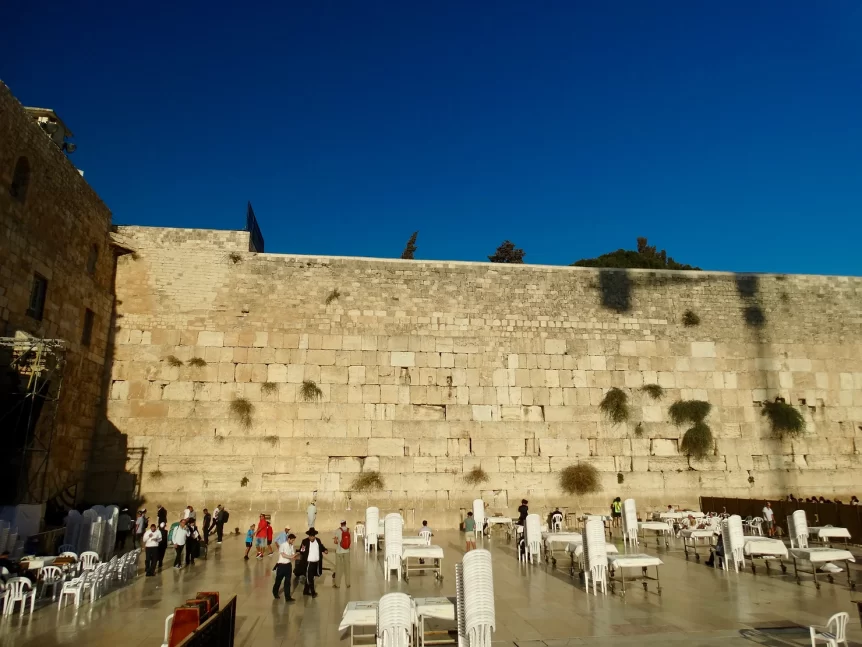I stood in the old city of Jerusalem gazing at the Western Wall.
An enduring reminder of the glory that once stood on the temple mount. The great expanse of stone is only a small part of the once grand structure.
I stool still
Silent
A mix of emotions
Watching pilgrims from around the world approach the wall
In a world drunk with hate, I’d unconsciously plodded through a metal detector and past armed security. Nothing unusual. Terrorism barely raises an eyebrow. Fear has faded into complacency. We go through the motions—numb to the thought that it could ever happen to us.
But there is a greater threat than terrorism.
Apathy
The dying cares of humanity flow like empty tears
Flooding our eyes, clouding our vision, voiding the sight of hope
Our tears flow into the never-ending, filled-and-overflowing sea of forgetfulness—the sea of grace
Life wanes beneath the wash of tears. Truly living dries like bones in a desert. And Life becomes a casual casualty.
The irony struck me as I stood facing the Western Wall with the Dome of the Rock and the Al-Aqsa mosque looming over it. Visitors mingling, talking, taking selfies. People from every part of the globe. Some connecting with the past. Some connecting with friends. Many trying to connect with God.
I stood at a distance. Observing. Pondering.
I felt no need to approach the wall. The temple is no longer there—and is no longer necessary.
I imagined Jesus sitting with his disciples on the Mount of Olives overlooking the Kidron Valley.
Beyond the valley, they could see the city of Jerusalem and the temple. What a spectacular sight it must’ve been. The house of God. The history. The majesty. The power inside that beautiful colossus.
The powerful images and emotions that must’ve stirred in their hearts as they sat listening to Yeshua (ישוע).
“Do you see all these things?” He said as He looked at Jerusalem.
I imagined him sitting against a tree and stretching his arm toward the city. I suspect he let those words hang for a minute as the disciples admired the temple.
I picture them in wonder as they considered the mysteries they’d never seen. The magnificent curtain—the veil that separated humanity from God—the entry into the Holy of Holies—the most sacred place on earth—the chamber into which only the high priest could dare to enter but one day each year.
In the very presence of the Creator, the priest would present himself, not in his ornate golden robes, but dressed only in white robes and soaked to the skin from the gathering of water and ritual cleansing.
A lottery would choose two goats, one to bear the wrongs and shortcomings of all the people in death upon the altar, the other to serve as the scapegoat and carry the shame and punishment of all the people into the desert.
Did the disciples realize what was happening? Did they know the Holy of Holies was essentially vanishing before their eyes. Their high priest sat beside them knowing he was the GOAT. He would bear their sins in death. He would carry the burden of all their shame and guilt as far as the east is from the west. He would bring the temple into the hearts of his followers.
How shocked they must’ve felt when they heard Jesus say, “I tell you the truth, not one stone here will be left on another. Every one will be thrown down.”
There would be no more temple. No more high priests but One to reign forever. No more goats to sacrifice. One Final Day of Atonement. One once-and-for-all Yom Kippur. One ultimate sacrifice—God Himself—Yeshua would stand in place of the high priest—in place of the sacrificial goats—in the place of Isaac’s ram—in place of every sacrificial lamb—all the blood that had been spilled across the ages. The Creator and Sustainer of all things would suffer the cruelest of deaths in our place. His blood for our blood. His chosen failure—His death to rescue us from ours.
He knew as He sat with His disciples reflecting on the wonder of His temple that with His final breath the wall of separation between humankind and God—the enormous veil would violently tear from top to bottom. The temple of God could never be destroyed but would reside forever in the hearts of His people.
So there I stood.
No temple made of stone.
But around me were hundreds of people trying to connect with God near a wall beneath a once holiest of all the holy places in the world—a place that no longer exists in stone.
We don’t need a temple made of stone.
We don’t need an artifact,
a sacred wall,
or any object to connect with God.
God became flesh and bone to connect with us.
So, there I stood feeling sadness for those looking for a temple that’s no longer there—looking for God but missing Him.
He is there.
He is here.
He is everywhere.
And He is ready to enter His most sacred place—the place He holds so dear that He bled and died to gain entry.
He is ready to live in our hearts.


